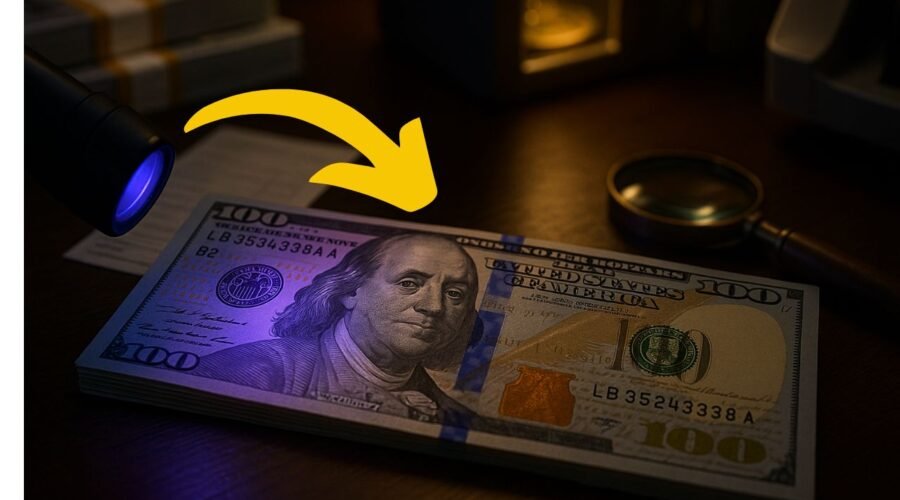2013 $100 Bills- Security Thread Signs Of A Big Payday
The 2013-series $100 (the “New Benjamin”) introduced advanced anti-counterfeiting tech that also helps collectors spot valuable anomalies.
If you can quickly verify the note’s security thread, 3-D blue ribbon, and other authenticity markers—and then screen for star notes, fancy serial numbers, and printing errors—you might turn an ordinary bill into a big payday.
Security Thread — Your First And Fastest Check
Hold the bill up to light. A thin embedded security thread runs vertically to the left of Franklin’s portrait.
It shows repeating microtext (USA and denomination) that is inside the paper, not printed on top. Under UV light, that thread glows in a distinctive color specific to the $100 denomination.
If the strip is missing, crudely printed on, or the glow is off, you either have a counterfeit—or, in very rare cases, a dramatic production error that can attract collectors.
3-D Blue Ribbon — Woven, Not Printed
The bold blue security ribbon in the center is woven into the paper, not surface-printed.
Tilt the note and watch the tiny bells and “100s” move—side-to-side when you tilt forward/back, and up-and-down when you tilt side-to-side.
Counterfeits often show flat, printed imitation. A mis-positioned or oddly woven ribbon can indicate a legitimate printing error with premium potential.
Other Authentication Clues
- Bell In The Inkwell: The copper-colored inkwell on the front contains a color-shifting bell that transforms as you tilt the note.
- Color-Shifting 100: The large 100 in the lower-right corner on the front shifts from copper to green.
- Watermark: A faint Benjamin Franklin watermark is visible from both sides when held to light.
- Raised Printing & Microprinting: Genuine notes have textured ink and crisp microtext (for example around Franklin’s collar and the borders).
What Actually Makes A 2013 $100 Worth More
- Star Notes: Replacement notes marked with a ★ can have lower print runs or special appeal, especially in uncirculated condition.
- Fancy Serial Numbers: Collectors pay premiums for low serials (000000xx), ladders (12345678), repeaters (ABABABAB), radars (ABCCBA), and meaningful dates.
- Major Printing Errors: Genuine misalignments, missing or doubled elements, severe ink smears, or marginal miscuts are rare—and can sell for multiples of face value when authenticated.
- Condition: Crisp, uncirculated notes bring the strongest prices. Store promising bills flat in a sleeve; avoid folds, moisture, and rubber bands.
Quick Reference — Spotting Value & Verifying Security
| Feature/Factor | What To Look For | Why It Matters | Practical Check |
|---|---|---|---|
| Security Thread | Embedded strip left of Franklin; microtext inside paper; correct UV glow | Core authenticity test; anomalies can mean counterfeit or rare error | Hold to light; test under UV |
| 3-D Blue Ribbon | Woven ribbon with moving bells/“100s” | Hard to fake; mis-weave can be collectible | Tilt both directions; confirm it’s in the paper |
| Bell In Inkwell | Bell appears/disappears; color shift | Verifies optical features | Tilt under bright light |
| Watermark | Franklin visible from both sides | Standard counterfeit check | Hold to light |
| Star Note | Serial ending in ★ | Collectible replacement note | Check serial block/series |
| Fancy Serial | Ladders, radars, repeaters, low numbers, birthdays | Adds collector demand | Scan for patterns |
| Major Error | Off-center print, missing elements, big ink smear, miscut | Can bring strong premiums | Authenticate; consider grading |
| Condition | Crisp, no folds, sharp corners | Higher grade = higher value | Store in sleeve, handle minimally |
How To Check Your Bills Step-By-Step
- Authenticate First: Verify the security thread, 3-D blue ribbon, watermark, and color-shifting elements.
- Scan The Serial: Look for the ★ and patterns (ladders, repeaters, radars, birthdays, low numbers).
- Inspect For Errors: Check margins, print alignment, and ink areas for obvious production flaws.
- Protect Condition: If promising, don’t fold it—use a currency sleeve.
- Get An Opinion: For high-value finds, consider third-party grading to confirm authenticity and maximize resale.
FAQs
Do All 2013 $100 Bills Have A Security Thread?
Yes. Genuine notes include an embedded thread that is visible when held to light and shows a specific glow under UV for the $100 denomination.
Is The Blue Ribbon Just Printed Ink?
No. The 3-D blue ribbon is woven into the paper. Tilt the bill—bells change to “100s” and appear to move in different directions.
What Adds The Most Value—Star Notes, Fancy Serials, Or Errors?
While all can add value, authenticated major errors and scarce star/fancy serial combinations in top condition usually command the highest premiums.


Leave a Reply